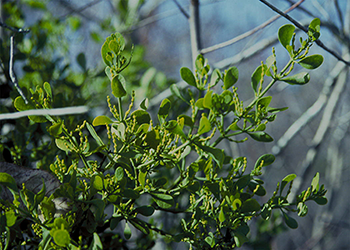
By Terry W. Johnson
Now that Thanksgiving, Black Friday and Cyber Monday are behind us, it is time to begin focusing our attention on Christmas … and beyond buying gifts.
For example, plants play a key role in our celebration of this festive holiday. One way we prepare our homes for the holiday season is to surround ourselves with a very small group of plants we consider Christmas plants. This select group includes evergreen trees, poinsettias, hollies and mistletoe. But what most don’t realize is that the mistletoe growing in the tops of the hardwood trees in their yard is far more than a magical Christmas plant. It is a valuable wildlife food plant.
Oddly, mistletoe is one of the most unlikely plants associated with the holiday. Why? For starters, while its berries are eaten by a wide variety of wildlife, they are poisonous to humans. The plant also once was known by a truly horrible name. The word “mistletoe“ literally means dung-on-a-stick. It came from the old belief that mistletoe plants spontaneously formed from bird droppings left on branches.
If that is not enough, the practice of adorning our homes with sprigs of mistletoe is linked to pagan practices by the Druids. It seems these members of ancient Celtic culture would hang mistletoe in their homes in winter, convinced they were providing warm sanctuaries for woodland spirits that hid in the plant during harsh weather. It’s not surprising the plant was banned from Christian churches for centuries.
And the custom of kissing beneath a frond of mistletoe? That probably evolved from Norse mythology. One of their myths is that because mistletoe is dedicated to the Goddess of Love, if a couple embraces beneath a tree that has a mistletoe plant, they will be healthy and experience good luck.
Washington Irving, author of “The Legend of Sleepy Hollow,” says good manners allow kissing beneath a branch of mistletoe only while berries are still on the plant. Each time someone steals a kiss they are supposed to remove a berry. Anyone so rash as to try a kiss beneath a berryless frond of mistletoe is out of line.
All myths and bad behavior aside, mistletoe’s value as a wildlife food plant is unquestioned. The list of animals that eat mistletoe is impressive, and many of these critters inhabit backyards across our state. Insects top the list. The best known and most beautiful is the great purple hairstreak. This butterfly nectars on the mistletoe's tiny blossoms and uses the plant as its host plant.
But when mistletoe is blooming, scores of insects descend on the flowers in search of nectar or pollen. The pollinators include the likes of honeybees, native bees, flies, ants and more.
Mistletoe is also a source of both forage and berries for mammals and birds. From late fall into winter, balls of mistletoe plants are adorned with translucent white berries. These are eaten by squirrels and eastern chipmunks. However, they must compete with birds, which are especially fond of the allegedly magical berries.
The lineup of birds that try to consume their share of these wild berries includes the American goldfinch, cedar waxwing, eastern towhee, blue jay, American robin, northern flicker, eastern bluebird, dark-eyed junco, eastern meadowlark, purple finch and white-breasted nuthatch.
A fascinating relationship exists between the plant and the birds that eat its berries. In exchange for providing birds with food, birds sow the mistletoe's seeds far and wide.
Each berry contains two to three seeds encased in a sticky pulp. Some of the seeds are dispersed through bird droppings; others by bill wiping. When a bird that has eaten mistletoe wipes its bill on a branch, there is a good chance the sticky pulp and seeds are both spread on the branch.
Some researchers go so far as to suggest the berries contain a substance that encourages birds to wipe their bill soon after they have dined on the berries. Since mistletoe seeds often only grow on the same species of tree on which they were produced, the sooner the bird wipes its bill, the better the chances it will deposit mistletoe seeds on a tree of the same species.
The plant's foliage is also relished by white-tailed deer. But since most mistletoe grows well above their reach, whitetails do not often get to eat this protein-rich forage. Typically, mistletoe is only available after a tree with mistletoe is cut down or a branch containing the plants breaks and falls to the ground.
Now that you know mistletoe’s jaded past as well as its prized value to our wildlife neighbors, do you still feel mistletoe is worthy of being touted as a magical Christmas plant? I know I do.
Terry W. Johnson is a retired Nongame program manager with the Wildlife Resources Division and executive director of The Environmental Resources Network, or TERN, friends group of the division’s Nongame Conservation Section. (Permission is required to reprint this column.) Learn more about TERN, see previous “Out My Backdoor” columns, read Terry’s Backyard Wildlife Connection blog and check out his latest book, “A Journey of Discovery: Monroe County Outdoors.”




















